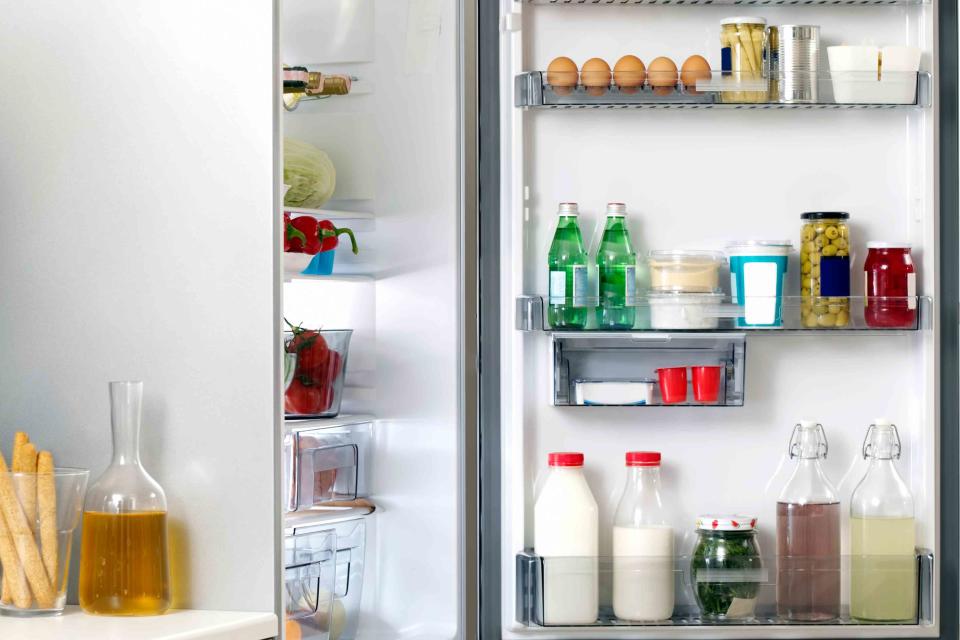7 Questions to Ask Yourself When Decluttering the Refrigerator
Give your fridge the decluttering it deserves.

JazzIRT/Getty Images
Sure, you open your fridge every day (and probably multiple times a day, too), but how often do you really look in it? It might feel a little cluttered—perhaps you have to reorganize every time you grab out a condiment jar or throw out the moldy and neglected vegetables that hide in the crisper drawer. If this is you, then decluttering the refrigerator may be in your future. We consulted with experts to determine the biggest questions to ask yourself while decluttering your fridge.
Related:The Best Way to Organize Your Fridge (and How to Keep It Organized)
Ask Yourself...
What's edible, and what do you actually eat?
Start any refrigerator decluttering project by discarding everything inedible or past its use-by date. While you’re at it, toss foods no one ever eats. Use apps and websites like supercook.com to plan dishes that incorporate unused ingredients. If doing this sounds like a chore, refrain from purchasing items you’ll likely use only once.
Does it even belong in the fridge?
Where you store many food items is a matter of personal preference. If fridge space is tight, consider moving breads to a cabinet or drawer, store-bought nut butters to the pantry, snack fruits to a bowl, and butter and even some cheeses to a countertop container.
Related:How to Arrange Your Refrigerator Shelves and Drawers by Food Group
Am I shelf smart?
Many people never reposition fridge shelves. Empty your refrigerator completely and refill to match what you store. You want a tight fit with an inch or less of headspace for the tallest items. Try this formula on for size: one shelf for tall items, one for big items, and the other shelves for thin items and containers.
What am I doing about depth?
Aim for three rows or fewer in your refrigerator. Arrange first by height with tall containers in the rear so shorter items in front remain visible. Foods you grab daily (lunch supplies, breakfast essentials, snacks) should be nearer the front and at an eye level that makes sense for the users of the items. Further tame your fridge’s depth by adding skinny bins that extend into the back.
What goes bad first?
If your fridge is typical, the most perishable items are leftovers, produce, and dairy, so allocate your best fridge real estate for these items. Nothing should block you from using these likely-to-expire items.
You eat more produce (and fewer processed snacks) when you can see it. Short on counter space? Opt for a pedestal bowl or platter.
Does everyone know where things belong?
Introduce your household to all rules and expectations (then remind them, perhaps multiple times). Label shelves, bins, and refrigerator door compartments so everyone knows what belongs where. Use grid paper to create a simple fridge map that lives on the side of the appliance.
Can I swap that for square?
Covered bowls, canisters, and cylindrical food storage containers all have the same problem—they’re round. Ditch these items for square and rectangular versions (check the office supply and bathroom sections at your favorite mass retailer) and truly make every cubic inch count.
Clear acrylic organizers are an investment, so after you purge and sort, use old cardboard boxes to stage the zones. Then purchase the right number and sizes of containers.
From the Pros
“Review your fridge for unusual, once-used items. Do you plan on making the recipe associated with an ingredient in the next month? Will you hunt down another recipe to use this item? If not, let it go. If the item is unexpired, offer it to local friends and family along with your recipe (if you liked it, of course).” —Kathy Vines, professional organizer
“Swap out the stuff in a perishables bin with jars and bottles from the door shelves, because you won’t overlook the ketchup or mustard in a drawer. Better yet, you’ll actually see those fresh herbs or specialty veggies—and remember to use them before they go bad.” —Jamie Novak, professional organizer
For more Real Simple news, make sure to sign up for our newsletter!
Read the original article on Real Simple.


